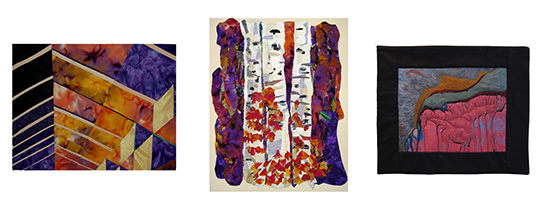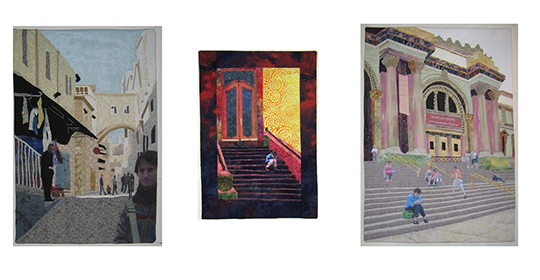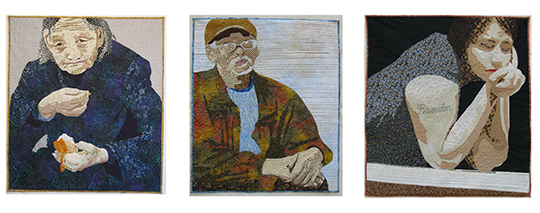Ready to Enter Shows? Here's Your First Step
Posted by Leni Levenson Wiener on May 9th 2017
This is the first of a series of articles that will appear in this blog addressed to emerging art quilters who are ready to move from hobbyist to more serious artist. It isn’t hard … if you know the ropes.
Maybe you have been making art quilts for a while and are ready to start entering juried shows. You have probably taken classes, purchased books, or experimented on your own. Most people don’t realize that there are some important things to know before making this step. I learned the hard way, so I want to share my experience with you so you won’t make the same mistakes I made.
Like many emerging art quilters, when I started entering shows I was working in three distinctly different styles: pieced work based on architecture; raw edge machine appliqué nature studies; and abstract thread paintings. Every time I entered a show I submitted one of each, thinking I was showing the jurors my “range” as an artist. I didn’t get into a single show that year. I thought long and hard about why I had received so many rejections and decided it must be that rather than showing them my range, I was actually showing the jurors I still didn’t know who I was as an artist.

Examples of the three styles from my first year of entering shows.
That got me thinking about how to create a body of work that all came together and looked like mine and no one else’s. For the next year, I only created new work that I wanted to make, without thinking about entering shows. I kept the raw edge machine appliqué, which was my favorite way to work; I used architecture as the setting in my pieces—a great way to create depth and dimension; I incorporated thread painting for fine details; and in addition, I added people to my work. When everything looked as if it came from the same person, I entered shows again, and that year I got into every single show I entered.

A more cohesive assortment the next year.
What can you learn from this experience? To begin with, you need to find a style, technique, and even a subject matter that represents you as an artist. If you have been taking classes, you need to keep all the things you have learned that support your own artistic decisions and throw the rest away. The worst thing you can do when entering shows is to present work that looks like someone else (especially a well-known teacher). Why would they take your derivative work when they could have the original?
Here are some things to think about in order to create a cohesive body of work:
• Find a subject matter that moves you. I love nature and animals and all sorts of things but what really inspires me are people. From that first year of working in a cohesive and consistent manner until now, more than a decade later, that is what I have been known for—depictions of strangers in ordinary moments, caught unaware of onlookers. In the intervening years, I have been invited to participate in many invitational shows that at first glance don’t feel like they fit who I am as an artist, but I always find a way to add the human element that is the focus of my body of work. That means all my work, regardless of whether it was created just for me or for a specific exhibition, fits together and looks like mine.

Even this invitational about turtles contains human hands.
• Find a technique you love. I can still remember every single point in one of my early pieced, architecture art quilts that I had to rip out and do again. I did not enjoy piecing. Raw edge machine appliqué was more my style—sitting at the sewing machine doing free-motion stitching is, for me, the most fun I can have with a sewing machine. Find what you love and don’t fight it. Embrace it.
• The same holds true for a color palette and even the size and orientation of your work. How often do we instantly recognize an art quilter’s work simply because of the colors used? I can think of several quilters off the top of my head whose color palette is their calling card. Find a size you are comfortable with as well, but make sure it fits the minimum or maximum for most calls for entry.
• Once you focus on creating what you want to create and following your own instincts, the calls for entry start to fall into place. Once you're no longer frantically working from one deadline to the next, you can read the specs and look through your body of work for something that fits. Nothing fits? Maybe this call for entry isn’t for you. Or maybe it intrigues you, and you do want to make something specifically for it, but only if that resulting piece will fit together with the rest of your work. Resist the urge to run off on a tangent.
An interesting thing happens when your work starts to look like your own; here’s how I knew that I had a style that was unique to me. In that year of finally getting into shows, one of the shows that had accepted my art quilt was close enough to go see (this is frustratingly not always the case, but it is so exciting when you can see your work hanging!). I went to the show and was standing near my piece when two women approached. One said to the other, “I think this is a Leeny Weener.” Her friend leaned over to read the card and proclaimed, “You are right, it IS a Leeny Weener.” I interjected, “Actually, it's pronounced Lenny Wine-er,” and she said, defiantly, “Oh no, it isn’t.” Actually, I was thrilled. Someone I didn’t know, who clearly didn’t know me, recognized my work. I had a distinct artistic voice, and I had arrived! I was an artist.

My work continues to evolve in a straight line.
Take some time to reflect on what you want to say with your art quilts before you jump into trying to enter exhibitions. You will find in the long run it is worth the effort. Don’t forget, this isn’t just about getting into a show here or there, it is about building a brand and a body of work that grows with you as you grow artistically. It is about having your name mispronounced by a stranger who knew your work before even looking at the card.
Watch this blog for the next article in this series, the ins and outs about what you need to know to enter shows—and get accepted.
Visit Leni Levenson Wiener, author of Pictorial Art Quilt Guidebook, at www.leniwiener.com.







